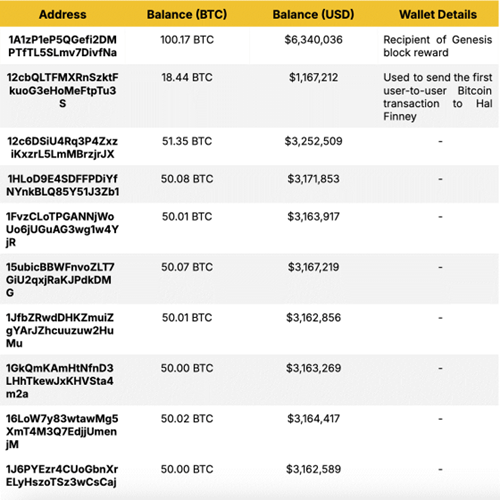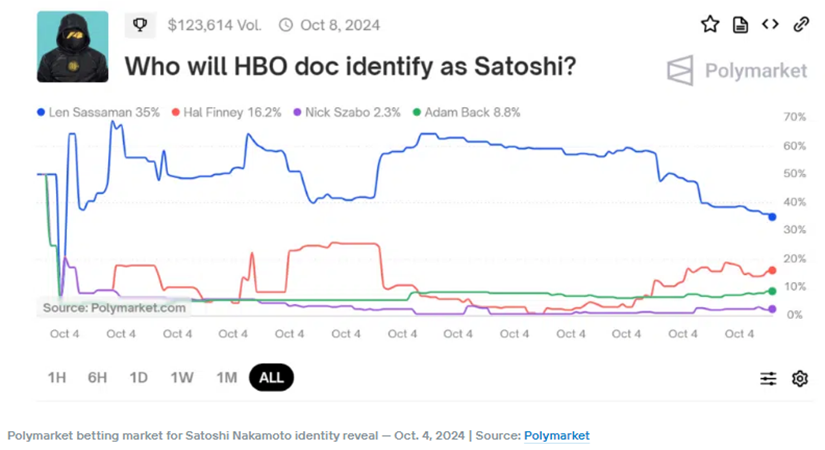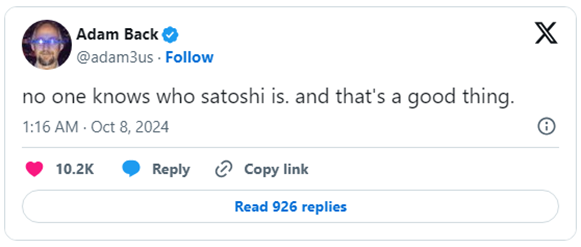For the last 15 years, the mystery around Satoshi Nakamoto has fascinated the world. Journalists, bloggers, and filmmakers have tried to unmask the person or group behind the pseudonym. The latest effort comes from HBO’s “Money Electric: The Bitcoin Mystery”.
This article explores the theories, and lasting intrigue surrounding Satoshi Nakamoto and what it means for Bitcoin's future trajectory.
Money Electric: The Bitcoin Mystery
The HBO documentary “Money Electric: The Bitcoin Mystery” premiering last Tuesday, is the latest attempt to solve one of the biggest mysteries in digital history: the true identity of Bitcoin’s creator, Satoshi Nakamoto.
Throughout the two-hour documentary, key figures from the cryptocurrency world are interviewed and various leads explored, ultimately pointing the finger at Peter Todd, a well-known Canadian developer in the Bitcoin community. The film hints that he might be the person behind the pseudonym, although Todd categorically denies being Satoshi.
HBO’s theory rests on a series of intriguing details. In 2010, Peter Todd replied to a post by Satoshi Nakamoto on the Bitcoin talk forum. The documentary suggests Todd may have accidentally used his own account instead of posting as Nakamoto.
After this, both accounts went silent. Later, Todd implemented the "Replace-by-Fee" (RBF) concept, a feature that allows you to modify a Bitcoin transaction by adding additional fees, which had been discussed in that same post. It was suggested that he used the pseudonym "John Dillon" to promote the concept, which was also linked to Satoshi.
Another connection noted is that both Todd and Nakamoto used British/Canadian spelling. Additionally, Nakamoto's activity on the forum, more frequent on weekends, matched Todd's schedule while he was a student. The documentary also pointed to Todd’s past comments about “sacrificing” Bitcoin, interpreting it as a reference to the potential "destruction" of Nakamoto’s Bitcoin holdings, further suggesting he could be Satoshi.
What we know for sure
Satoshi Nakamoto is the pseudonym used by the individual or group that created Bitcoin and played an active role in its development until 2010. Here is what we know:
- He authored and published the Bitcoin whitepaper “Bitcoin: A Peer-to-Peer Electronic Cash System” on October 31, 2008.
- He registered and established the domain bitcoin.org.
- In 2009, he mined the very first block, known as the Genesis Block, and marked the beginning of the Bitcoin blockchain.
- He communicated on the BitcoinTalk forum under the alias “Satoshi”.
- He abruptly stepped back in 2011 stating that he had "moved on to other things".
As of 2024, Bitcoin is the world’s most valuable cryptocurrency, with a market capitalisation over $1.2 trillion. According to researchers, Nakamoto holds between 800,000 and 1.1 million Bitcoins, a fortune now valued at around $70 billion, yet these coins have remained untouched.
These Bitcoins are believed to be spread across approximately 22,000 wallets. Researcher Sergio Demian Lerner's "Patoshi Pattern" is considered one of the most reliable approaches to identifying Nakamoto's mining activity. His theory says that certain wallets display a distinct pattern of behaviour: they remain dormant, show a 99% likelihood of not spending any Bitcoin, and abruptly stopped mining activities after Satoshi’s disappearance. While Lerner does not claim these wallets belong to Nakamoto, their prolonged inactivity and isolated behaviour patterns suggest a possible link to Bitcoin's founder.
Source: Potential Satoshi Nakamoto wallets, Blockchain.com
Previous theories
For over a decade, the search for Satoshi Nakamoto's identity has sparked many theories. In anticipation of the HBO documentary, the prediction platform Polymarket recorded over $20 million in bets concerning the identity the documentary would reveal as Satoshi Nakamoto. Len Sassaman, Hal Finney, Nick Szabo, and Adam Back were considered the most likely candidates. Interestingly, Peter Todd was not mentioned by users as a potential candidate.
Source: Polymarket
Len Sassaman is a cryptography expert known for his work on Pretty Good Privacy (PGP), a programme that enhances the security of digital communications. He became a subject of speculation after taking his own life just months after Satoshi Nakamoto’s final email. On Polymarket, odds that Sassaman could be Nakamoto spiked to over 60% over the weekend, but dropped after his widow denied the theory and confirmed that the documentary team never approached her during its production.
Hal Finney is the first person to ever receive Bitcoin from Nakamoto and is the creator of the Reusable Proof-of-Work system, crucial to Bitcoin mining. Nick Szabo is a computer scientist and cryptographer known for creating Bit Gold, an early prototype for Bitcoin, and for inventing smart contracts.
Adam Back is a cryptographer who developed Hashcash, a proof-of-work system crucial for Bitcoin mining. In 2019, a documentary pointed to Back as a possible Satoshi, a theory he later rejected.
Other suspects have been dismissed in the past. Dorian Nakamoto, a Japanese American engineer, was famously misidentified as Bitcoin’s creator in 2014 due to his name, but he has repeatedly denied any involvement. Craig Wright, an Australian computer scientist, claimed to be Satoshi in 2015. Some publications suggested Wright might be Bitcoin’s creator, citing leaked emails and documents that were later ruled as fabricated by the courts and he failed to provide cryptographic proof.
Other rumours point to Elon Musk, the tech mogul behind Tesla (NASDAQ:TSLA) and SpaceX, as being Satoshi, though Musk has denied any involvement. Another theory suggests that Satoshi Nakamoto could represent a group of companies, with the name as an acronym for SAmsung, TOshiba, NAKAmichi, and MOTOrola.
What if Satoshi is unmasked?
If upper estimates are correct, Satoshi Nakamoto holds around 1.1 million Bitcoins, worth nearly $70 billion. This amount makes up about 5% of the total Bitcoin supply. This naturally raises concerns about what could happen to the market if Satoshi were to suddenly reappear and move his Bitcoin holdings.
The most obvious concern would be a massive sell-off, which could create market panic and send Bitcoin prices plummeting. However, this scenario is relatively unlikely. Satoshi’s Bitcoins are spread across thousands of wallets, and moving all of them at once would be complicated. Even if Satoshi coordinated the transactions from all his wallets, Bitcoin’s liquidity has grown since Satoshi was last active, with daily trading volumes often exceeding $6 billion, according to Glassnode. This deep liquidity could absorb some of the impact. There is also the concern of security, but the distribution of Satoshi's Bitcoin makes it complex and time-intensive for hackers to breach multiple wallets that are heavily protected and offline.
There have been occasional suggestions to ban early UTXOs (unspent transaction outputs), proposing a network fork to exclude these coins. However, this idea has not gained much traction, as it runs counter to Bitcoin's fundamental value of being censorship resistant. Additionally, many in the Bitcoin community believe that Satoshi is entitled to its Bitcoin holdings, even if he decides to sell it, given his role in the creation of Bitcoin.
Beyond the mystery, Bitcoin’s true value
Whether or not HBO has cracked the Nakamoto riddle, the documentary confirms Bitcoin's growing mainstream recognition. Satoshi Nakamoto’s identity is secondary to Bitcoin's fundamental value proposition as a decentralised store of value and hedge against currency debasement. Bitcoin’s core principle, free from centralised control, remains unaffected.
For nearly 14 years, Satoshi has stayed out of sight, without making any moves that could disrupt the market. Even if he were to return, he would not hold control over Bitcoin’s future. The network's development is now in the hands of a global community, ensuring that no individual — not even its original architect—can singlehandedly alter its core principles.
Bitcoin was always intended to transcend its creator, and Satoshi’s decision to hide his identity is a calculated move to strengthen the decentralised nature of the system. His goal was to address the inherent flaw in traditional currencies; “the root problem with conventional currency is all the trust that’s required to make it work,” as he once was quoted. By staying anonymous, Satoshi eliminated the potential for personal bias and central authority, ensuring that Bitcoin could develop naturally as a community-driven initiative.



